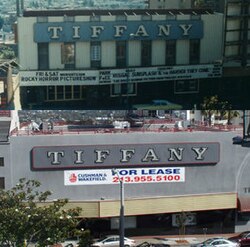The Tiffany was ready to reopen in June, 1985 as two separate 99-seat live theaters, though there was a several month delay due to a conflict with Actors Equity. [11] Once the Union's issues were resolved, the Tiffany became an active home for small, but respected, performances, featuring some well-known or soon-to be famous cast members. Among the more high-profile offerings was a four-month run of an updated The Rocky Horror Show, which opened on January 29, 1999 and starred David Arquette. Not coincidentally, the original Rocky Horror Show had its US opening at the Roxy Theater, a few blocks down the Sunset Strip from the Tiffany.
Live productions at the Tiffany
1985: Rain
1986: The Killing of Michael Malloy
1989: Wolverines (Tom Patchett)
1989: King of Hearts (Edward Winter, Courteney Cox, Michael Spound, Larry Randolph)
1990: "Laughing Wild" (Christopher Durang) Playwrite & Performer, Dennis Erdman (Director), Grant Shaud and Christine Ebersole (Christine would be replaced by (Jean Smart) during rehearsals and after a few performances Grant Shaud would be replaced by the Playwrite (Christopher Durang)
1990: Blossom Dearie (in a 2-week musical engagement, in May)
1990: A Shayna Maidel
1992: Woman in Mind ( Helen Mirren, Paxton Whitehead, Angela Payton, J.D. Cullum, Marsha Dietlein, John Getz, Tony Carlin) Maps for Drowners (Lisa Kudrow, Marion Ross, Norman Reedus - 6 weeks, beginning in April)
1992: Give 'Em Hell, Harry (Jason Alexander)
1993: "Lady - Like" (Donna Emett, Georgia Phillips, Kevin Richardson, Sam Lloyd, Antony Carbone, Jill Tracy, Mark Snelson, Carol Arthur, Joe R. Sicari,, Liz Torres)
1994: Oleanna (Kyra Sedgwick)
1994: Marvin's Room (Mary Steenburgen, Jean Smart, Jane Cecil, Tim Monsion)
1995: Staccato (Eugene Robert Glazer, Cameron Watson, Sarah MacDonnell, Anthony Russell, Edith Fields)
1995: Why We Have a Body (Amy Resnick, K. K. Dodds, Shareen Mitchell)
1995: Fatty
1995: Twist of Fate (Lisa Raggio, Dan Gerrity, Tia Texada)
1996: The Apple Doesn't Fall Far Drom The Tree (Directed by Leonard Nimoy—opened Feb 22)
1996: Kindertransport (Holland Taylor, Kala Savage, Jane Kaczmarek, Elizabeth Hoffman)
1996 All I Really Need to Know I Learned in Kindergarten (Beth Howland, Robert Mandan, David Naughton, Michael Tucci)
1996: Tight Quarters (Rio Hibler-Kerr, John Ganun, Reece Holland, Tony Spinosa, James Michael Connor, Julianne Buescher, Ric Stoneback, Gary Paul Clark, Chuck Rosen)
1996: The All Night Strut (Steve Gideon, Lance Roberts, Andrea Chamberlain and Sharon Young-Fuller)
1997: Star Dust (Joan Van Ark, Vanessa Marshall)
1997: There Once Was a Girl From Pawtucket (Joanne Baron, Jackie Green)
1997: Lullaby of Broadway (Nathan Holland, Kirby Tepper, James Matthew Campbell)
1998: Crooks
1998: The Last Session
1999: The Rocky Horror Show (David Arquette, Eric Leviton, Bob Simon, Timothy A. Fitz-Gerald, Lacey Kohl, Donnie Kehr, Kirsten Benton, Hynden Walch, Paxton Whitehead)
1999: Wet Weather Cover (Oliver Cotton, Richard Zavaglia, Ian Ogilvy)
1999: Talk About Money (John Saxon, Tom Astor)
1999: Scent of Rain: A Love Story Really! (Nicholas Conlon, Ryan Idol)
2000: Detachments (Glenne Headly)
2000: Confidentially, Cole (Bryan Schimmel, Cliff Hayden)
2000: A Private Spirit . . . The Music and Wit of Noel Coward (Don Snell)
2001: Call Waiting . . . A Painful Comedy! (Caroline Aaron)
2001: Diablogues (Alan Goodson, Joe Hulser Larry Cox, Christy Keefe, Samantha Bennett)
2001: An Intimate Evening With Lypsinka (John Epperson - benefit for the American Foundation for AIDS Research)
2001: Seltzer-Man (David Proval)
2001: Joe Louis Blues (Russell Hornsby, Shelley Robertson, Ellis E. Williams, Barry Primus, Sterling Macer Jr., Gregg Daniel)
2001: Back From Broadway (Hershey Felder, James Barbour )
2002: Five One Act Plays: Stolen Child (Mike Weaver, Lanette Ware) Boise, Idaho, Daniel on a Thursday, Homecoming and Who's on Top


